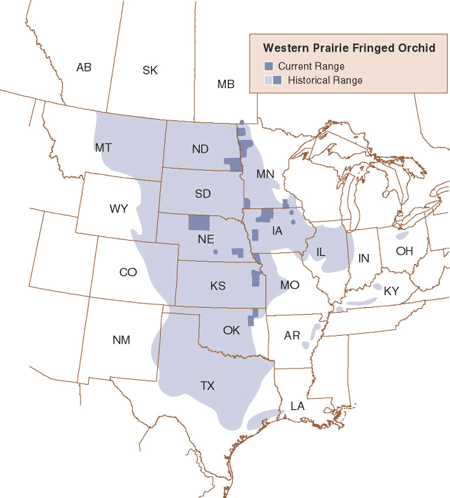Conserving Borderline Species: A Partnership between the United States and Canada
Plant
Western Prairie Fringed Orchid (Platanthera praeclara)
Status
Canada (COSEWIC): Endangered
U.S. (USFWS): Threatened

Photo Donald Gunn
Description
The western prairie fringed orchid is a tall, erect, long-living perennial plant. The smooth stem grows to about 1 meter (about 3 feet) in height. The orchid grows two to five leaves that are thick and hairless. Each stalk produces an average of 20 large white to creamy flowers about 2.5 centimeters (1 inch) long. The lip, or lower petal, of each flower is deeply three-lobed and fringed. The sepals are tinged with pale green.
Ecology
The western prairie fringed orchid occurs mostly in remnant native prairies and meadows, usually alone or in small groups. It emerges in late May and blooms in July. The flowers can last 10 days, and can be pollinated by only a few species of insects. Reproduction occurs by seed, with each seed capsule producing many thousands (perhaps millions) of tiny, wind- or water-dispersed seeds. For seedlings to become established, a specific fungus must be present in the soil that provides the plant with water and nutrients.
Causes of Decline
Historically, the western prairie fringed orchid extended from Minnesota, Montana, and North Dakota south as far as Texas. Orchid numbers declined with the conversion of its tall-grass prairie habitat to cropland. They now occur mostly in southeastern Manitoba (where they were discovered in the 1980s), Minnesota, and North Dakota. In recent years, researchers have also discovered several populations in Nebraska. The number of flowering plants can fluctuate from year to year. The highest number observed in recent years in Manitoba was about 21,000 flowering plants, and about 15,000 flowering plants in the entire United States. The orchid occurs most often in wet, uncultivated prairie and meadows, but has been found in old fields and roadside ditches. Current threats include introduced invasive plants, filling of wetlands, intensive hay mowing, fire suppression, and overgrazing. Severe weather fluctuations, such as drought, flooding, and frost, as well as contact with herbicides used to control weeds also threaten the orchid.

Research and Recovery
In the late 1990s, scientists in Canada and the United States prepared separate recovery plans for the western prairie fringed orchid. The Canadian plan drew heavily from the American one. In 1999, Canadian and U.S. scientists established a western prairie fringed orchid working group. The group hopes to advance the recovery of this species across jurisdictional boundaries throughout its range. Primary working group goals include sharing information on the biology of the species, cooperating to improve management and stewardship, prioritizing recovery needs, and working together to obtain funding for recovery efforts. Initially, this group has focused on the northern part of the species' range, but also exchanges information with contacts in more southern states where the orchid occurs. About 80 percent of known orchid sites are protected in preserves or other publicly managed areas, mostly in Manitoba, Minnesota, and North Dakota. The group met in North Dakota in the summer of 1999 and Manitoba in the summer of 2000. Scientists made presentations on orchid research, management, and recovery efforts.
The working group is seeking funding to develop and implement a pilot program of "orchid friendly" management agreements with private landowners. Many orchid sites occur on private lands, where farmers or other landowners have maintained the species through conservation-minded agricultural practices. Biologists have launched an initial pilot project in North Dakota, and participating agencies are assisting in developing guidelines for grazing, burning, or weed control to maintain and/or enhance orchid habitat. In Manitoba, under a prairie management plan, the provincial government and several wildlife groups have also begun negotiating land purchases and conservation agreements with landowners. In Minnesota, wildlife officials are conducting periodic prescribed burning on most orchid preserves, which reduces mulch build-up and controls the increase of invasive grasses that can threaten the orchid. Grazing, which also reduces mulch, is permitted in some orchid preserves, such as in the Sheyenne National Grassland of North Dakota.

